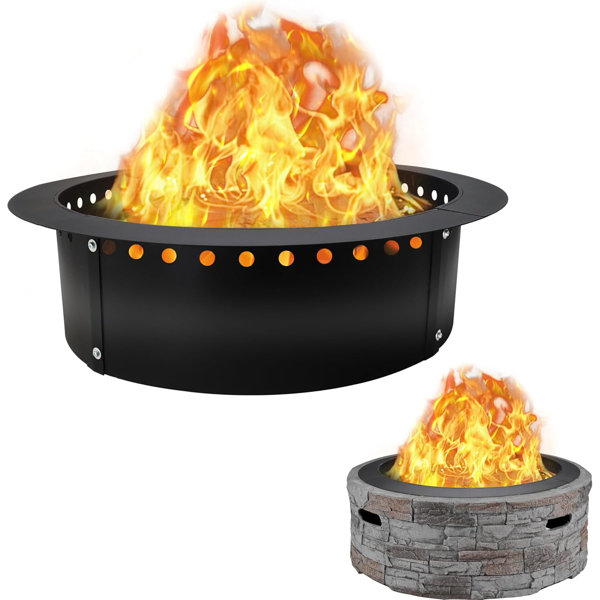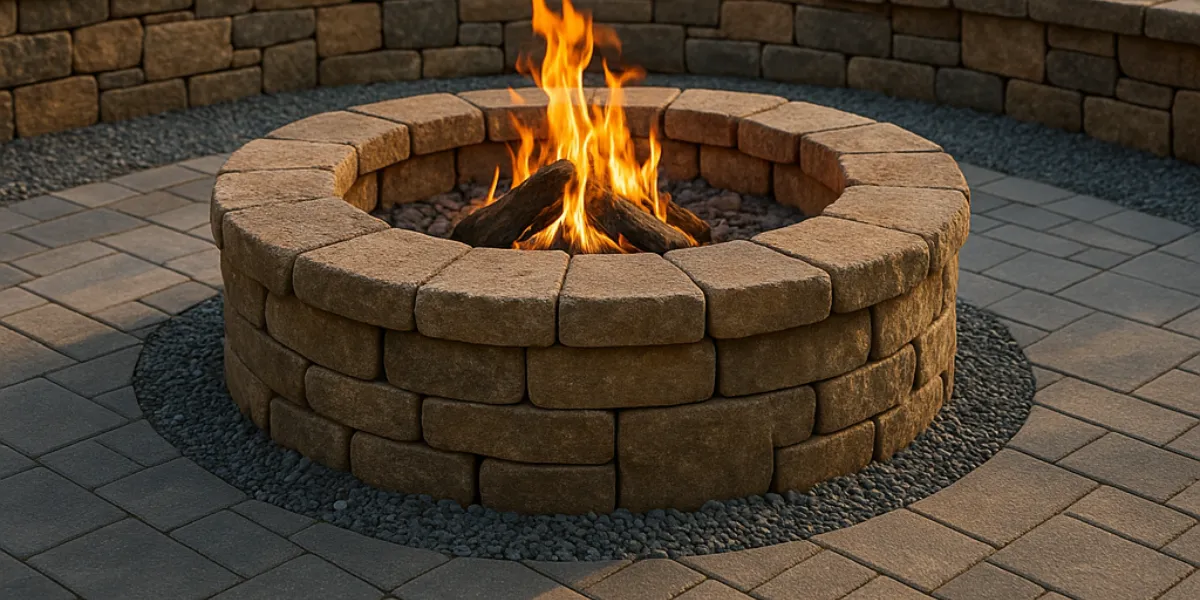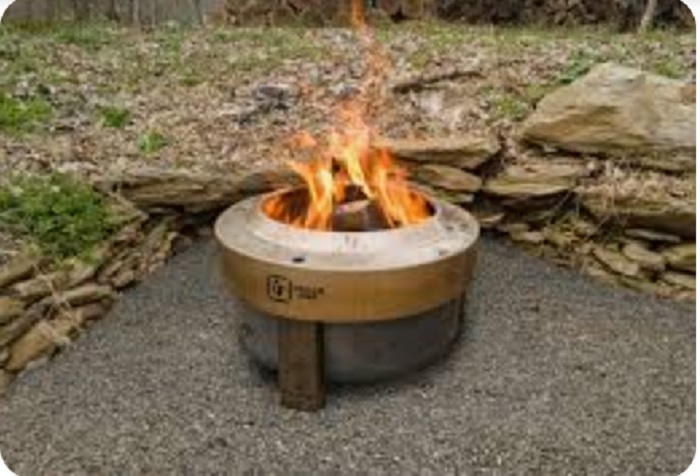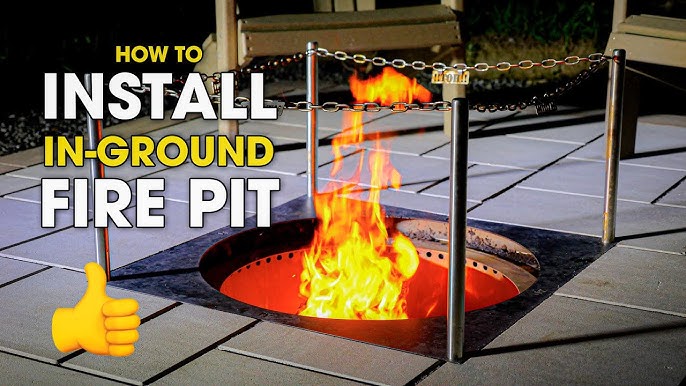Imagine sitting around a fire pit without the annoying smoke that stings your eyes and ruins your fun. What if you could enjoy a warm, cozy fire while your friends relax comfortably, free from smoke clouds?
Building a smokeless fire pit is easier than you think, and it can transform your outdoor gatherings. In this guide, you’ll discover simple steps to create a fire pit that burns cleaner and keeps the smoke away. Ready to enjoy smoke-free nights by the fire?
Let’s dive in and make it happen.
Benefits Of A Smokeless Fire Pit
Smokeless fire pits offer many benefits for outdoor gatherings. They burn wood more cleanly, creating less smoke.
These fire pits make outdoor time more enjoyable and healthier. You can enjoy warmth without the usual smoke problems.
Reduced Air Pollution
Smokeless fire pits reduce harmful smoke in the air. They burn fuel more efficiently and produce fewer pollutants.
Less smoke means less impact on the environment. This helps keep the air cleaner around your home and neighborhood.
Enhanced Outdoor Experience
Without smoke, you can sit closer to the fire. This makes talking, cooking, and relaxing outdoors more fun.
Smokeless fire pits also reduce eye irritation and smell. Your clothes and hair stay fresher after spending time near the fire.
Health Advantages
Smoke from regular fires can cause coughing and breathing problems. Smokeless fire pits lower these risks by cutting smoke output.
People with asthma or allergies can enjoy the fire safely. Cleaner air means better health for everyone around the fire pit.
Choosing The Right Location
Picking the right spot for your smokeless fire pit is very important. The location affects safety and how well the fire pit works.
Think about space, wind, and nearby objects before placing your fire pit. This will help you enjoy it safely and comfortably.
Safety Considerations
Keep your fire pit away from anything that can catch fire. Trees, bushes, and wooden decks are risky spots.
Make sure the area around the fire pit is clear and flat. This helps prevent accidents and keeps the fire controlled.
- Place fire pit at least 10 feet from buildings
- Clear leaves, dry grass, and flammable materials nearby
- Use a fire-resistant surface like gravel or stone
- Keep a fire extinguisher or water nearby
Optimal Ventilation
Good airflow helps your fire burn cleanly and reduces smoke. Avoid closed or crowded spaces.
Open areas with natural wind flow are best. This helps the fire get enough oxygen for a smokeless burn.
- Choose a spot with open sky above
- Avoid corners or places blocked by walls or fences
- Check wind direction to keep smoke away from seating areas
Local Regulations
Check your city or county rules before building a fire pit. Some places have rules about where and how you can use them.
Following local laws keeps you safe and avoids fines. Some areas require permits or have fire bans during dry seasons.
- Contact local fire department for rules
- Ask if permits are needed
- Learn about seasonal fire restrictions
- Follow rules about distance from property lines
Materials Needed
Building a smokeless fire pit needs the right materials. These materials help keep the fire safe and clean.
Choosing good materials can make your fire pit last longer and work better.
Fire-resistant Bricks And Stones
Fire-resistant bricks and stones hold heat well. They protect the fire pit from heat damage.
Use bricks that can handle high temperatures without cracking or breaking.
- Refractory bricks designed for ovens and fireplaces
- Natural stones like granite or lava rock
- Concrete blocks made for heat resistance
Metal Components
Metal parts help shape and support your fire pit. They also guide airflow to reduce smoke.
Choose metals that resist rust and can handle high heat safely.
- Steel rings or plates for the fire pit edge
- Metal grates to hold wood above the base
- Air vents or tubes made from steel or iron
- Heat-resistant screws or bolts for assembly
Tools And Accessories
You need some tools to build and use your fire pit safely. These help with assembly and maintenance.
Good tools make the building process easier and the fire pit safer to use.
- Gloves to protect your hands from heat and sharp edges
- A level to keep the structure even
- A hammer and chisel for shaping bricks or stones
- A drill or screwdriver for metal parts
- A wire brush to clean metal components
- A fire extinguisher for safety
Designing Your Fire Pit
Building a smokeless fire pit starts with a good design. A well-planned fire pit burns clean and looks great in your yard.
Think about how big it should be, how air will flow, and how to handle ashes. These details make your fire pit safe and easy to use.
Size And Shape Options
The size of your fire pit depends on your space and how many people will use it. Smaller pits are good for cozy groups. Bigger pits fit larger gatherings.
Shape affects how the fire burns and how you sit around it. Round shapes spread heat evenly. Square or rectangular shapes fit better in corners.
- Small (2-3 feet wide) for small spaces
- Medium (3-4 feet wide) for average backyards
- Large (4+ feet wide) for big groups
- Round for even heat
- Square or rectangular for corner spots
Ventilation Systems
Good airflow keeps the fire burning hot and reduces smoke. Vent holes or pipes let air reach the fire from below.
Some designs have two layers with vents in the bottom layer. This lets fresh air feed the fire and pushes smoke up and out.
- Place vents near the bottom for fresh air
- Use double walls to create an air channel
- Keep vents clear of ash and debris
- Adjust vents to control fire strength
Incorporating Ash Collection
Ash collection makes cleaning easier and keeps your fire pit tidy. Design a tray or drawer under the fire area to catch ash.
This system stops ash from blocking air vents. It also helps you remove ashes without making a mess.
- Build a removable ash tray below the fire bowl
- Use metal or heat-resistant materials
- Make sure ash collection does not block airflow
- Empty ash regularly for best performance
Building Steps
Building a smokeless fire pit takes careful planning and work. Follow the steps to make a safe and efficient fire pit.
This guide shows how to prepare the base, build walls, and add airflow channels for a smokeless fire pit.
Preparing The Base
Choose a flat, stable spot for your fire pit. Clear away grass, leaves, and debris from the area.
Dig a shallow hole about 6 inches deep and 3 feet wide. This will hold the fire pit base and keep it steady.
- Pick a level ground area
- Remove plants and rocks
- Dig 6 inches deep and 3 feet wide
- Fill hole with gravel for drainage
Constructing Walls
Use fire-resistant bricks or stones to build the walls. Arrange them in a circle around the base.
Stack the bricks at least 12 inches high. Leave small gaps between bricks for airflow.
- Choose fireproof bricks or stones
- Build a circular wall around the base
- Stack bricks 12 inches tall
- Leave gaps for air flow
Installing Airflow Channels
Create small holes or gaps at the bottom of the walls. These allow air to flow into the fire.
Install vertical channels inside the walls. They help draw air up and keep smoke low.
- Make holes near the base of the walls
- Add vertical air channels inside walls
- Ensure air moves freely to the fire
- Test airflow before lighting fire

Credit: mysalama.com
Fuel Choices For Clean Burning
Choosing the right fuel helps keep your fire pit smokeless. Clean burning fuels reduce smoke and pollution.
Using proper fuel also makes your fire pit safer and more enjoyable. Let’s explore good fuel options.
Types Of Wood
Hardwoods burn cleaner than softwoods. They produce less smoke and last longer.
Seasoned wood with low moisture gives the best results. Wet wood causes more smoke and sparks.
- Oak: dense and burns slowly
- Maple: good heat and low smoke
- Hickory: strong heat and clean burn
- Birch: burns fast and clean
Alternative Fuels
Besides wood, you can use other fuels to reduce smoke. These fuels burn cleaner and produce less ash.
Charcoal and wood pellets are popular choices for smokeless fire pits. They offer steady heat and less smoke.
- Charcoal: burns hot and clean
- Wood pellets: made from compressed sawdust
- Natural gas: no smoke and easy control
- Propane: burns clean with no ash
Avoiding Toxic Materials
Never burn treated or painted wood. These release harmful chemicals when burned.
Avoid trash, plastics, or wet materials. They cause thick smoke and dangerous fumes.
- Stay away from plywood and particleboard
- Do not burn plastics or rubber
- Avoid wet or green wood
- Never use painted or stained wood
Lighting And Maintaining The Fire
Building a smokeless fire pit means you need to light and keep the fire burning well. Good fire care helps you enjoy clean smoke-free flames.
Focus on starting the fire right, managing airflow, and cleaning the pit often for the best results.
Starting Techniques
Start your fire with dry wood and small kindling pieces. Dry wood burns cleaner and gives less smoke.
Use natural fire starters like dry leaves or paper to help the fire catch quickly. Avoid using chemical starters.
- Place kindling in a teepee shape for good airflow
- Light the kindling from several sides for even burning
- Add larger logs only after the fire is strong
Managing Airflow
Airflow controls how the fire burns and how much smoke it makes. Good airflow keeps the fire hot and clean.
Open vents or air holes in the fire pit help air move through the fire. Adjust these vents to keep the fire burning well.
- Keep vents clear of ash and debris
- Use a grate to lift wood and allow air underneath
- Add wood gradually to avoid smothering the fire
Cleaning And Upkeep
Cleaning your fire pit regularly stops ash buildup. Ash blocks airflow and causes more smoke.
Remove ashes after each use when they are cool. Check vents and grates for any blockages.
- Dispose of ash safely in a metal container
- Clean air vents to keep them open
- Inspect the fire pit for cracks or damage

Credit: www.whiteoaknw.com
Troubleshooting Common Issues
Building a smokeless fire pit can be easy with the right steps. Sometimes, problems like smoke or damage may happen. This guide helps you fix common issues quickly.
Knowing what causes these problems helps keep your fire pit safe and working well. Read each section to learn simple ways to solve these problems.
Excess Smoke Causes
Too much smoke means the fire is not burning right. Wet wood or poor airflow often cause this. Smoke can also come from dirty fire pits or wrong fuel.
Check your wood for dryness and use smaller pieces. Make sure air can flow well inside the fire pit.
- Use dry, seasoned wood only
- Keep firewood small and light
- Clean ash and debris often
- Ensure air vents are open
Fire Pit Damage
Fire pit damage can happen from heat or weather. Cracks or rust weaken the structure. Using wrong materials can cause fast damage.
Check your fire pit regularly for cracks or rust. Use heat-resistant materials and cover it when not in use.
- Use fireproof stones or metal
- Check for cracks after each use
- Apply rust protectant if metal
- Cover fire pit during rain or snow
Improving Burn Efficiency
Good burn efficiency means less smoke and more heat. Proper airflow and right wood size help. Building a double-wall or adding vents can improve burning.
Keep the fire small and feed wood regularly. This keeps air flowing and the fire burning clean.
- Build vents or holes for air
- Use small, dry wood pieces
- Feed wood slowly and often
- Keep fire size moderate
Safety Tips
Building a smokeless fire pit is fun and useful. You must keep safety in mind to prevent accidents. Follow these safety tips for a safe fire pit experience.
Good safety habits protect you, your family, and your property. Use the right tools and stay alert around fire.
Fire Control Measures
Control the fire size to keep it safe. Do not let flames grow too high. Use dry, clean wood to reduce smoke.
Clear the area around the fire pit from leaves and other flammable materials. Always keep a bucket of water or sand nearby.
- Keep fire small and manageable
- Use only dry wood or charcoal
- Clear flammable items within 10 feet
- Have water, sand, or a fire extinguisher ready
Protective Gear
Wear protective gear to avoid burns and injuries. Use heat-resistant gloves when handling firewood or tools.
Long sleeves and closed shoes help protect your skin from sparks. Avoid loose clothing that can catch fire easily.
- Heat-resistant gloves
- Long-sleeved shirts
- Closed-toe shoes
- Avoid loose or synthetic fabrics
Emergency Preparedness
Be ready for emergencies by keeping safety tools close. Know how to use a fire extinguisher and keep a phone nearby to call help.
Teach family members what to do in case of fire. Have a clear escape path and never leave the fire unattended.
- Keep a fire extinguisher nearby
- Have a phone ready to call emergency services
- Teach fire safety to all family members
- Never leave fire unattended
- Clear escape routes near the fire pit
Enhancing Your Fire Pit Experience
Building a smokeless fire pit lets you enjoy fires without smoke irritation. It makes your outdoor time more fun and relaxing.
To improve your fire pit experience, focus on seating, lighting, and cooking options. Each adds comfort and joy to your gatherings.
Seating Arrangements
Good seating around your fire pit brings people closer. Choose seats that are safe and comfy for everyone.
Arrange chairs or benches in a circle or semi-circle. This setup helps people talk and enjoy the fire equally.
- Use weather-resistant chairs or benches
- Add cushions for extra comfort
- Keep space for easy movement
- Include side tables for drinks or snacks
Lighting Effects
Good lighting sets the mood around your fire pit. It helps create a cozy and safe environment at night.
Use soft lights like string lights or lanterns near the seating area. Avoid bright lights that can spoil the fire’s glow.
- Hang string lights on nearby trees or poles
- Place solar lanterns on tables or ground
- Use LED candles for gentle light
- Install dimmable lights for control
Cooking Over The Fire Pit
A smokeless fire pit is great for cooking. You can grill, roast, or toast food safely and cleanly.
Use a grill grate or skewers to cook over the fire. Keep tools handy for easy cooking and serving.
- Use a metal grill grate for burgers and veggies
- Roast marshmallows or hot dogs on skewers
- Keep a fireproof glove nearby for safety
- Clean the cooking surface after each use

Frequently Asked Questions
What Is A Smokeless Fire Pit?
A smokeless fire pit is designed to reduce smoke emissions. It uses a double-wall structure to enhance airflow. This design allows for more complete combustion of the wood. As a result, less smoke is produced. It’s ideal for outdoor gatherings where smoke can be a nuisance.
How Does A Smokeless Fire Pit Work?
A smokeless fire pit works by improving air circulation. The double-wall construction creates a secondary combustion process. This process burns off particles that would normally become smoke. The improved airflow keeps the fire hot and efficient. This results in a cleaner, smokeless burn.
What Materials Are Needed To Build One?
To build a smokeless fire pit, you need metal barrels or steel rings. You’ll also need a drill and some basic tools. Some designs require a grate for better airflow. High-temperature paint is useful for finishing touches. Ensure all materials are heat-resistant for safety.
Are Smokeless Fire Pits Safe To Use?
Yes, smokeless fire pits are generally safe when used properly. Their design reduces the risk of excessive smoke inhalation. Always place them on a stable, non-flammable surface. Ensure proper ventilation in the area. Following safety guidelines will minimize risks and enhance your outdoor experience.
Conclusion
Building a smokeless fire pit brings warmth without the smoke. It makes outdoor time more fun and clean. Use the right materials and follow the steps carefully. This helps the fire burn better and reduces smoke. Enjoy cozy nights with friends and family around your fire pit.
Safe, easy, and enjoyable—your perfect backyard addition. Start small, and soon you will see great results. A smokeless fire pit is a smart choice for any home.

